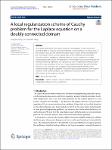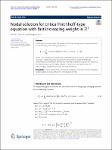Search
Author
- Carlos, Alegría (2)
- Carlos, Seara (2)
- David, Orden (2)
- Klaus, Bretterbauer (2)
- next >
Subject
Date issued
Has File(s)
- true (287)
Search Results
The Cauchy problem of the Laplace equation is investigated for both exact and perturbed data on a doubly connected domain, i.e., the numerical reconstruction of the function value and the normal derivative value on a part of the boundary from the knowledge of exact or noisy Cauchy data on the remaining and accessible boundary, which is completely different from the Cauchy problem on a simply connected bounded region. |
We study hyperelliptic curves y2=f(x) over local fields of odd residue characteristic. We introduce the notion of a “cluster picture” associated to the curve, that describes the p-adic distances between the roots of f(x), and show that this elementary combinatorial object encodes the curve’s Galois representation, conductor, whether the curve is semistable, and if so, the special fibre of its minimal regular model, the discriminant of its minimal Weierstrass equation and other invariants. |
The analysis developed in this paper also allows to investigate the relation between a Riesz-type of Schrödinger–Newton systems and a logarithmic-type of Schrödinger–Poisson systems. Furthermore, this approach can overcome some difficulties resulting from either the nonlocal term with sign-changing and unbounded logarithmic integral kernel, or the critical nonlinearity, or the lack of monotonicity of f(t)t3. We emphasize that it seems much difficult to use the variational framework developed in the existed literature to study the above problem. |
In statistical seismology, the Epidemic Type Aftershocks Sequence (ETAS) model is a branching process used world-wide to forecast earthquake intensity rates and reproduce many statistical features observed in seismicity catalogs. In this paper, we describe a fractional differential equation that governs the earthquake intensity rate of the pure temporal ETAS model by using the Caputo fractional derivative and we solve it analytically. We highlight that the tools and special functions of fractional calculus simplify the classical methods employed to obtain the intensity rate and let us describe the change of solution decay for large times. |
Answering a question of Conway and Guy (SIAM Rev. 11:78-82, 1969), Lángi (Bull. Lond. Math. Soc. 54: 501-516, 2022) proved the existence of a monostable polyhedron with n-fold rotational symmetry for any n≥3
, and arbitrarily close to a Euclidean ball. In this paper we strengthen this result by characterizing the possible symmetry groups of all mono-monostatic smooth convex bodies and convex polyhedra. Our result also answers a stronger version of the question of Conway and Guy, asked in the above paper of Lángi. |
One of the major challenges of coupled problems is to manage nonconforming meshes at the interface between two models and/or domains, due to different numerical schemes or domain discretizations employed. Moreover, very often complex submodels depend on (e.g., physical or geometrical) parameters, thus making the repeated solutions of the coupled problem through high-fidelity, full-order models extremely expensive, if not unaffordable. In this paper, we propose a reduced order modeling (ROM) strategy to tackle parametrized one-way coupled problems made by a first, master model and a second, slave model; this latter depends on the former through Dirichlet interface conditions. |
We consider the problem of computing the distance-based representative skyline in the plane, a problem introduced by Tao, Ding, Lin and Pei [Proc. 25th IEEE International Conference on Data Engineering (ICDE), 2009] and independently considered by Dupin, Nielsen and Talbi [Mathematics; Optimization and Learning - Third International Conference, OLA 2020] in the context of multi-objective optimization. Given a set P of n points in the plane and a parameter k, the task is to select k points of the skyline defined by P (also known as Pareto front for P) to minimize the maximum distance from the points of the skyline to the selected points. |
As we all know, we call problems of type (1.1) nonlocal problems because there is an integral over R2
. Such problems were first posed by G. Kirchhoff in [1] as an extension of the classical D’Alembert wave equation for free vibrations of elastic strings. |
A class of risk-neutral generalized Nash equilibrium problems is introduced in which the feasible strategy set of each player is subject to a common linear elliptic partial differential equation with random inputs. In addition, each player’s actions are taken from a bounded, closed, and convex set on the individual strategies and a bound constraint on the common state variable. Existence of Nash equilibria and first-order optimality conditions are derived by exploiting higher integrability and regularity of the random field state variables and a specially tailored constraint qualification for GNEPs with the assumed structure. |
The purpose of this paper is to explore the use of deep learning for the solution of the nonlinear filtering problem. This is achieved by solving the Zakai equation by a deep splitting method, previously developed for approximate solution of (stochastic) partial differential equations. This is combined with an energy-based model for the approximation of functions by a deep neural network. This results in a computationally fast filter that takes observations as input and that does not require re-training when new observations are received. The method is tested on four examples, two linear in one and twenty dimensions and two nonlinear in one dimension. The method shows promising performance when benchmarked against the Kalman filter and the bootstrap particle filter. |










